lazarus57 - He'll Have To Go (DUET)

lazarus57
Aug 20, 2025 10:49am
<p><span style="background-color: rgb(251, 251, 251); color: rgb(33, 37, 41);">REMEMBERING ELVIS</span></p><p><img src="https://singsnap-cdn.nyc3.digitaloceanspaces.com/message-board/threads/MVHF/8bc5ec63ae_HANR_media.gif"><img src="https://cdn.store-factory.com/www.lilot-parts.com/content/product_9406544b.jpg?v=1530701615" alt="Partition Elvis PRESLEY, Ry COODER, Solomon BURKE He ll Have To Go"></p><p><br></p><p>Later versions </p><p>"He'll Have to Go" has been recorded by many other artists. <a href="https://en.wikipedia.org/wiki/Elvis_Presley" rel="noopener noreferrer" target="_blank" style="color: rgb(51, 102, 204);">Elvis Presley</a> recorded his version of "He'll Have to Go" on October 31, 1976, at his last known studio recording session; it is believed to be the final song he ever recorded in a studio setting.<a href="https://en.wikipedia.org/wiki/He%27ll_Have_to_Go#cite_note-13" rel="noopener noreferrer" target="_blank" style="color: rgb(51, 102, 204);"><sup>[13]</sup></a></p><p><br></p><p><br></p><p><br></p><p>"<strong>He'll Have to Go</strong>" is a song recorded on October 15, 1959, by <a href="https://en.wikipedia.org/wiki/Jim_Reeves" rel="noopener noreferrer" target="_blank" style="color: rgb(51, 102, 204);">Jim Reeves</a>. The song, released in the fall of 1959, went on to become a hit on both the country and pop charts early in 1960.</p><p>Background</p><p>The song is about a man who is talking by telephone to the woman he loves, when he realizes that another man is with her. The song was written by the husband-and-wife team of <a href="https://en.wikipedia.org/wiki/Joe_Allison" rel="noopener noreferrer" target="_blank" style="color: rgb(51, 102, 204);">Joe</a> and Audrey Allison, and was inspired by a phone conversation between them in which they had trouble making themselves understood. Because of background noise and Audrey Allison's naturally soft voice, her husband had to ask her to put her mouth very close to the receiver.<a href="https://en.wikipedia.org/wiki/He%27ll_Have_to_Go#cite_note-2" rel="noopener noreferrer" target="_blank" style="color: rgb(51, 102, 204);"><sup>[2]</sup></a> That led her to pen the song's first line.</p><p>Reeves recorded the song after listening to the original version of it by singer Billy Brown. When Brown's version attracted little attention, Reeves felt free to record his own. It was released to country radio as the <a href="https://en.wikipedia.org/wiki/A-side_and_B-side" rel="noopener noreferrer" target="_blank" style="color: rgb(51, 102, 204);">B-side</a> of "In a Mansion Stands My Love", which some music executives considered a stronger song. However, "Mansion" failed to catch on, and disc jockeys began playing the B-side, instead.<a href="https://en.wikipedia.org/wiki/He%27ll_Have_to_Go#cite_note-3" rel="noopener noreferrer" target="_blank" style="color: rgb(51, 102, 204);"><sup>[3]</sup></a> Before long, "He'll Have to Go" became a huge country and pop hit. Several <a href="https://en.wikipedia.org/wiki/Rhythm_and_blues" rel="noopener noreferrer" target="_blank" style="color: rgb(51, 102, 204);">rhythm and blues</a> radio stations played the song, too.</p><p>The recording features a small group of musicians: <a href="https://en.wikipedia.org/wiki/Floyd_Cramer" rel="noopener noreferrer" target="_blank" style="color: rgb(51, 102, 204);">Floyd Cramer</a> on piano, Marvin Hughes on the vibraphone, <a href="https://en.wikipedia.org/wiki/Bob_Moore_(musician)" rel="noopener noreferrer" target="_blank" style="color: rgb(51, 102, 204);">Bob Moore</a> on bass, <a href="https://en.wikipedia.org/wiki/Buddy_Harman" rel="noopener noreferrer" target="_blank" style="color: rgb(51, 102, 204);">Buddy Harman</a> on drums, <a href="https://en.wikipedia.org/wiki/Hank_Garland" rel="noopener noreferrer" target="_blank" style="color: rgb(51, 102, 204);">Hank Garland</a> on guitar, and the <a href="https://en.wikipedia.org/wiki/Anita_Kerr_Singers" rel="noopener noreferrer" target="_blank" style="color: rgb(51, 102, 204);">Anita Kerr Singers</a> providing the background vocals.<a href="https://en.wikipedia.org/wiki/He%27ll_Have_to_Go#cite_note-4" rel="noopener noreferrer" target="_blank" style="color: rgb(51, 102, 204);"><sup>[4]</sup></a></p><p>The first verse set the tone: "Put your sweet lips a little closer to the phone/Let's pretend that we're together all alone/I'll tell the man to turn the juke box way down low/And you can tell your friend there with you he'll have to go."<a href="https://en.wikipedia.org/wiki/He%27ll_Have_to_Go#cite_note-pc10-1" rel="noopener noreferrer" target="_blank" style="color: rgb(51, 102, 204);"><sup>[1]</sup></a></p><p>Country music historian Bill Malone noted that "He'll Have to Go" in most respects represented a conventional country song, but its arrangement and the vocal chorus "put this recording in the country pop vein." In addition, Malone lauded Reeves' vocal styling - lowered to "its natural resonant level" to project the "caressing style that became famous" - as being why "many people refer to him as the singer with the velvet touch."<a href="https://en.wikipedia.org/wiki/He%27ll_Have_to_Go#cite_note-5" rel="noopener noreferrer" target="_blank" style="color: rgb(51, 102, 204);"><sup>[5]</sup></a></p><p>Chart performance</p><p>The song reached number two on the <a href="https://en.wikipedia.org/wiki/Billboard_Hot_100" rel="noopener noreferrer" target="_blank" style="color: rgb(51, 102, 204);"><em>Billboard</em> Hot 100</a> in early 1960, kept from the top spot by <a href="https://en.wikipedia.org/wiki/Percy_Faith" rel="noopener noreferrer" target="_blank" style="color: rgb(51, 102, 204);">Percy Faith</a>'s "<a href="https://en.wikipedia.org/wiki/Theme_from_A_Summer_Place" rel="noopener noreferrer" target="_blank" style="color: rgb(51, 102, 204);">Theme from <em>A Summer Place</em></a>".<a href="https://en.wikipedia.org/wiki/He%27ll_Have_to_Go#cite_note-6" rel="noopener noreferrer" target="_blank" style="color: rgb(51, 102, 204);"><sup>[6]</sup></a> <em>Billboard</em> ranked it as the number-two song of the year for 1960. The song also reached number one on the <a href="https://en.wikipedia.org/wiki/Hot_Country_Singles" rel="noopener noreferrer" target="_blank" style="color: rgb(51, 102, 204);">Hot Country Singles</a> chart on February 8, 1960, where it remained for 14 consecutive weeks.<a href="https://en.wikipedia.org/wiki/He%27ll_Have_to_Go#cite_note-7" rel="noopener noreferrer" target="_blank" style="color: rgb(51, 102, 204);"><sup>[7]</sup></a> The song was one of just five different titles to occupy the chart's summit during 1960. In addition, it reached number 13 on the <a href="https://en.wikipedia.org/wiki/Rhythm_and_blues" rel="noopener noreferrer" target="_blank" style="color: rgb(51, 102, 204);">rhythm and blues</a> singles chart.<a href="https://en.wikipedia.org/wiki/He%27ll_Have_to_Go#cite_note-8" rel="noopener noreferrer" target="_blank" style="color: rgb(51, 102, 204);"><sup>[8]</sup></a></p><p>In Canada, the song was number one for six weeks on the pop charts.<a href="https://en.wikipedia.org/wiki/He%27ll_Have_to_Go#cite_note-9" rel="noopener noreferrer" target="_blank" style="color: rgb(51, 102, 204);"><sup>[9]</sup></a> It also had success abroad, reaching number one on the Australian singles chart and number 12 on the <a href="https://en.wikipedia.org/wiki/UK_Singles_Chart" rel="noopener noreferrer" target="_blank" style="color: rgb(51, 102, 204);">UK Singles Chart</a>.<a href="https://en.wikipedia.org/wiki/He%27ll_Have_to_Go#cite_note-10" rel="noopener noreferrer" target="_blank" style="color: rgb(51, 102, 204);"><sup>[10]</sup></a></p><p><br></p><p><sup style="color: rgb(51, 102, 204);"><span class="ql-cursor"></span></sup><img src="https://i.ytimg.com/vi/cDNFb0KYlY0/maxresdefault.jpg" alt="Elvis Presley - He`ll have to go - cover - YouTube"></p>
